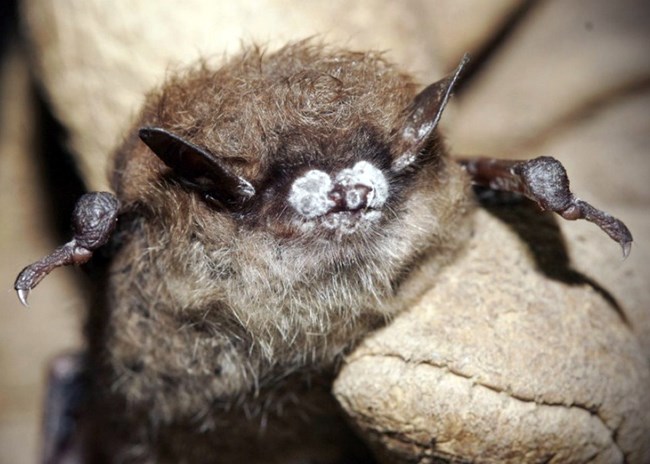Last updated: March 22, 2019
Article
Bat Acoustic Monitoring at Mount Rushmore National Memorial

NPS
Overview
Mount Rushmore National Memorial is a 1,278-acre park in the center of the Black Hills in South Dakota established to protect the faces of four presidents carved on the mountainside. Granite outcroppings and the old growth ponderosa pine forest that surrounds the mountain may provide good bat roosting habitat.
The Northern Great Plains Inventory & Monitoring Network monitors bats to detect long-term trends and to get early warning of undesirable changes in bat populations at the park. A fungal disease called white-nose syndrome is spreading quickly, threatening bat populations in North America. First documented in a New York cave in 2006, this disease is associated with more than seven million bat deaths. It spreads primarily from bat to bat and humans might be spreading the disease by carrying nearly invisible fungal spores on their shoes and clothing from one cave to another. Bat monitoring helps us understand changes occurring with the spread of this devastating disease.
Acoustic Monitoring
Ten acoustic recording stations were established in 2015 at Mount Rushmore National Memorial. Acoustic recorders detect the unique ultrasonic calls bats use for echolocation. There were 44,796 bat call recordings from stations across all survey nights from 2015 to 2017. The data were analyzed through specialized software programs that make preliminary identifications of the bat species based on individual call characteristics, such as frequency and shape. Some bat species make calls that are similar to other species, which is why researchers with special expertise review the calls and make the final species determinations.

NPS
Bats at the Park (2015–2017)
| Common Name | Scientific Name | 2015–2017 Status |
|---|---|---|
| Townsend's big-eared bat | Corynorhinus townsendii | Probably Present |
| Big brown bat | Eptesicus fuscus | Present |
| Eastern red bat | Lasiurus borealis | Present |
| Hoary bat | Lasiurus cinereus | Present |
| Silver-haired bat | Lasionycteris noctivagans | Present |
| Western small-footed myotis | Myotis ciliolabrum | Present |
| Little brown bat | Myotis lucifugus | Present |
| Northern long-eared bat | Myotis septemtrionalis | Probably Present |
| Fringed myotis | Myotis thysanodes | Probably Present |
| Long-legged myotis | Myotis volans | Present |
| Tri-colored bat | Perimyotis subflavus | Probably Present |
- Silver-haired and hoary bats were most commonly recorded, followed by big brown, eastern red, and little brown bats. Hear a silver-haired bat call!
- Eastern red, hoary, and tri-colored bats were new detections for the park. A very small number of the acoustic recordings were attributed to the threatened northern long-eared bat.
- The hoary bat, an open country flyer, was recorded most often in the open area around the visitor parking garages. The smaller and more maneuverable little brown bat was detected more often in forests.
- The station with the most bat recordings was at the old beaver pond in Starling Basin, a diverse site surrounded by forest with dead snags for roosting and a marsh where the beaver pond used to be. The clearing between the visitor parking garages had the next highest rate of bat activity, perhaps because bats forage on the insects attracted to the lights and warm surfaces.
- Preservation of the old growth ponderosa pine forest, including dead snags, will protect the diverse bat community at the park. Silver-haired bats, long-legged myotis, and northern long-eared bats are particularly reliant on high densities of snags.

USFWS/Marvin Moriarty
White-nose Syndrome
White-nose syndrome has not yet been detected at the park, but the fungus (Pseudogymnoascus destructans) that causes it was detected in 2017 on bats at nearby Badlands National Park. See a map of white-nose syndrome in national parks and learn more about how you can help prevent the spread of this fungus. Continued monitoring, and park staff and visitor observations, will help us protect the bat communities that live and forage in the park.
For More Information
Dan Licht, Midwest Region Wildlife BiologistProtocol Contact: Northern Great Plains Network
Summary created by Tani Hubbard, updated in 2019
